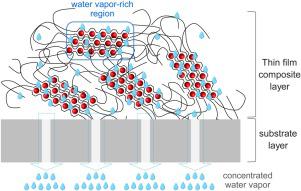Journal of Environmental Chemical Engineering ( IF 7.4 ) Pub Date : 2020-10-20 , DOI: 10.1016/j.jece.2020.104609 Yogita M. Shirke , Ali M. Abou-Elanwar , Soon Jin Kwon , Won-Kil Choi , Seong Uk Hong , Hyung Keun Lee , Jae-Deok Jeon

|
We synthesized polymeric calcium-alginate (CA) particles with an “egg box” structure using an emulsification additive process to enhance the performance of the thin film composite (TFC) membranes for water vapor separation. The appealing feature of CA particles is that they have a variety of hydrophilic groups, such as hydroxyl and carboxyl groups, which allow them to absorb more water vapor at a relatively rapid rate. Moreover, CA particles are readily available, inexpensive, and biocompatible. Moreover, they can be obtained by one-pot synthesis, which is a relatively simple and convenient method. These particles can be characterized with different techniques. Transmission electron microscopy (TEM) mapping data and X-ray photoelectron spectroscopy (XPS) data illustrate fundamentally that CA particles consist of mostly calcium and oxygen. Energy dispersive X-ray (EDX) data show that the calcium rises from 0 to 0.41 atomic percent when CA content increases from 0.0 to 0.35 wt%. Water vapor/nitrogen gas permeation results show that relatively more CA particles in the polyamide (PA) layer increases the water vapor permeation due to the increased number of sorption sites and greater surface area provided by the particles with their many hydrophilic functional groups. The TFC membrane with 0.1 wt% CA loading shows the best performance such as water vapor permeance of 2143 GPU and selectivity of 706. Thus, adding a small amount of polymeric CA particles to a PA layer can enhance the performance of TFC membranes, making them a viable candidate for water vapor separation membranes.
中文翻译:

海藻酸钙聚合物颗粒在增强复合膜水蒸气分离性能方面的作用
我们使用乳化添加剂工艺合成了具有“蛋盒”结构的聚合物海藻酸钙(CA)颗粒,以增强用于水蒸气分离的薄膜复合材料(TFC)膜的性能。CA颗粒的吸引人的特征是它们具有各种亲水基团,例如羟基和羧基,这使它们能够以相对较快的速度吸收更多的水蒸气。而且,CA颗粒容易获得,便宜且生物相容。而且,它们可以通过一锅合成获得,这是一种相对简单和方便的方法。这些颗粒可以用不同的技术表征。透射电子显微镜(TEM)映射数据和X射线光电子能谱(XPS)数据从根本上说明了CA颗粒主要由钙和氧组成。能量色散X射线(EDX)数据显示,当CA含量从0.0到0.35 wt%时,钙从0原子百分比提高到0.41原子百分比。水蒸气/氮气的渗透结果表明,聚酰胺(PA)层中相对较多的CA颗粒会增加水蒸气的渗透,这是由于具有许多亲水性官能团的颗粒提供的吸附位点数量增加和表面积增大。CA含量为0.1 wt%的TFC膜表现出最佳性能,例如2143 GPU的水蒸气透过率和706的选择性。因此,在PA层中添加少量聚合CA颗粒可以增强TFC膜的性能,从而使它们水蒸气分离膜的可行候选物。当CA含量从0.0重量%增加到0.35重量%时为41原子%。水蒸气/氮气的渗透结果表明,聚酰胺(PA)层中相对较多的CA颗粒会增加水蒸气的渗透,这是由于具有许多亲水性官能团的颗粒提供的吸附位点数量增加和表面积增大。CA含量为0.1 wt%的TFC膜表现出最佳性能,例如2143 GPU的水蒸气透过率和706的选择性。因此,在PA层中添加少量聚合CA颗粒可以增强TFC膜的性能,从而使它们水蒸气分离膜的可行候选物。当CA含量从0.0重量%增加到0.35重量%时为41原子%。水蒸气/氮气的渗透结果表明,聚酰胺(PA)层中相对较多的CA颗粒会增加水蒸气的渗透,这是由于具有许多亲水性官能团的颗粒提供的吸附位点数量增加和表面积增大。CA含量为0.1 wt%的TFC膜表现出最佳性能,例如2143 GPU的水蒸气透过率和706的选择性。因此,在PA层中添加少量聚合CA颗粒可以增强TFC膜的性能,从而使它们水蒸气分离膜的可行候选物。水蒸气/氮气的渗透结果表明,聚酰胺(PA)层中相对较多的CA颗粒会增加水蒸气的渗透,这是由于具有许多亲水性官能团的颗粒提供的吸附位点数量增加和表面积增加。CA含量为0.1 wt%的TFC膜表现出最佳性能,例如2143 GPU的水蒸气透过率和706的选择性。因此,在PA层中添加少量聚合CA颗粒可以增强TFC膜的性能,从而使它们水蒸气分离膜的可行候选物。水蒸气/氮气的渗透结果表明,聚酰胺(PA)层中相对较多的CA颗粒会增加水蒸气的渗透,这是由于具有许多亲水性官能团的颗粒提供的吸附位点数量增加和表面积增大。CA含量为0.1 wt%的TFC膜表现出最佳性能,例如2143 GPU的水蒸气透过率和706的选择性。因此,在PA层中添加少量聚合CA颗粒可以增强TFC膜的性能,从而使它们水蒸气分离膜的可行候选物。











































 京公网安备 11010802027423号
京公网安备 11010802027423号